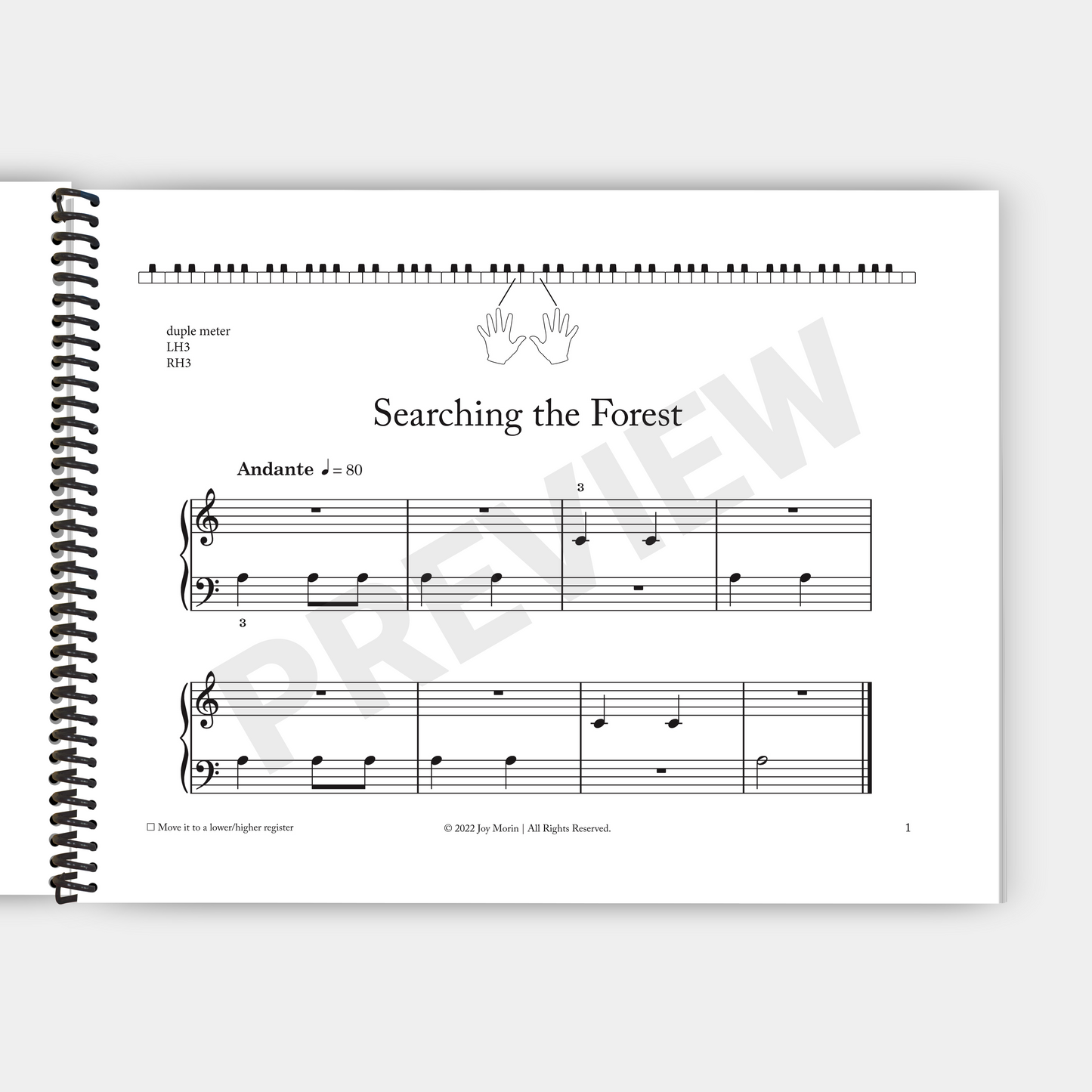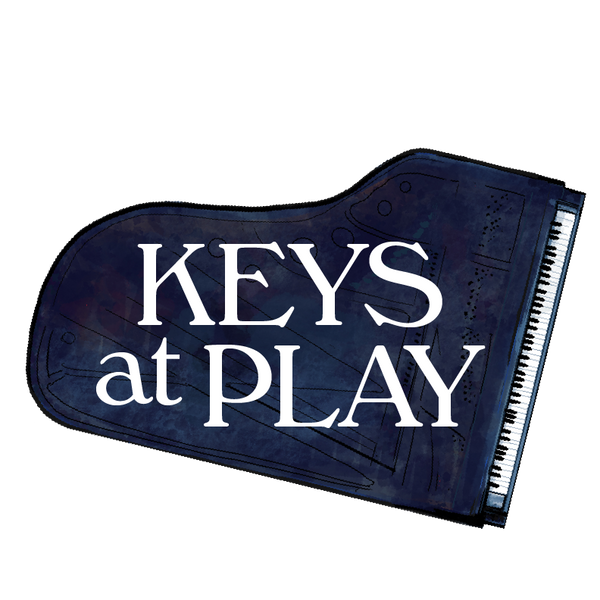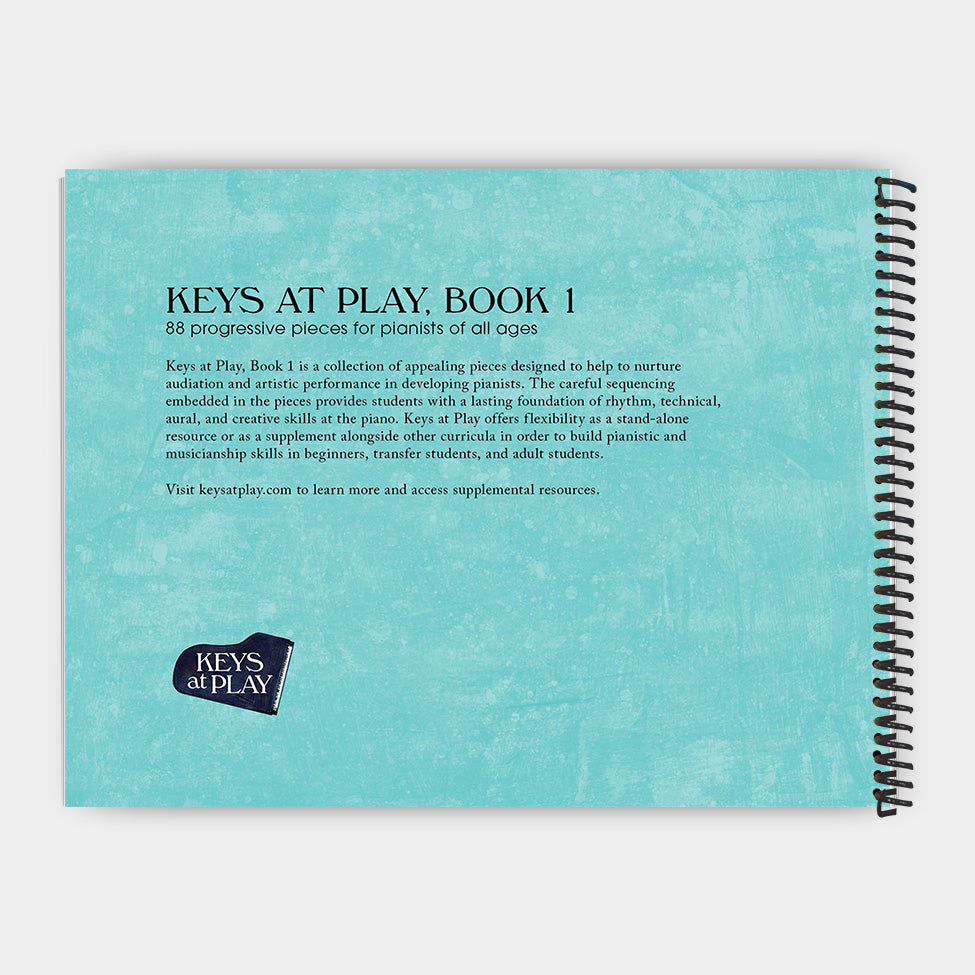Keys at Play, Book 1
Keys at Play, Book 1
88 progressive pieces for pianists of all ages
Couldn't load pickup availability
Keys at Play, Book 1 is a collection of 88 appealing pieces designed to help to nurture audiation and artistic performance in developing pianists. The careful sequencing embedded in the pieces provides students with a lasting foundation of rhythm, technical, aural, and creative skills at the piano. Keys at Play offers flexibility as a stand-alone resource or as a supplement alongside other curricula in order to build pianistic and musicianship skills in beginners, transfer students, and adult students.
Note: Accompanying audio tracks and a Teacher’s Guide providing duets for all 88 pieces are coming soon!
>>> Take advantage of special launch pricing and order now! <<<
Features
Features
THE MUSIC: Keys at Play, Book 1 contains 88 short, tuneful pieces with imaginative, descriptive titles. A variety of tonalities beyond major and minor are used (mixolydian, dorian, etc.), providing rich acculturation and appealing music for piano students and teachers.
PACING: If the student learns 2-4 pieces per week, they will complete the book in 6-12 months.
FLEXIBILITY: Keys at Play can function as a stand-alone resource or a supplement alongside another piano method. For MLT-trained (Music Learning Theory) piano teachers, Keys at Play can function as a source for supplemental rote/reading pieces for students using Marilyn Lowe’s Music Moves for Piano method (especially students in Book 2 or 3). For teachers new to MLT or interested in a blended approach, Keys at Play provides an easy way to introduce certain concepts (especially rhythm concepts) to students in an audiation-friendly way. Alternatively, try it as a remedial “rhythm book” or “sight-reading book” for any student of any age, and watch their skills improve!
NOTE VS. ROTE: The early pieces in Book 1 are best taught largely by ear/rote, with a healthy amount of ear training activities to support the careful rhythm sequencing in the book (e.g., echoing, discussing, demonstrating how to read rhythm patterns). After that, you can use a mixture of both note and rote learning, gradually guiding students towards reading and audiating independently.
METER AND RHYTHM: Duple meter and triple meter are introduced side-by-side and reinforced equally, so students have sufficient opportunity to master both. The time signatures used are “two quarter time” and “two dotted-quarter time” (essentially, 2/4 and 6/8 time). Although this may seem like an unusual way to start, it is quite effective. Many students are already accustomed to seeing eighth note rhythms in music class at school and will find the beaming helps them easily recognize familiar rhythm patterns in both duple and triple. I recommend using the Gordon-Froseth rhythm syllables: DU DE (“doo day”) for duple meter and DU DA DI (“doo dah dee”) for triple meter, but you may use any counting system of your preference. Especially when accompanied by movement and aural activities, Keys at Play produces strong rhythm skills in students.
RHYTHM PATTERNS: Rhythm patterns used in the pieces are carefully sequenced according to aural difficulty and playing difficulty, so students build rhythm skill naturally and with less struggle.
CREATIVITY: “Comparison pieces” are interspersed to enable students to learn rhythm concepts through recognizing differences. By applying similar rhythmic alterations to subsequent pieces, students have opportunity to achieve deep mastery of rhythm skills and flex their creative muscles. Through learning to make small changes to pieces – especially using concepts they are learning – students will experience the beginnings of true creativity and improvisation at the piano.
TECHNIQUE: Technique skills are sequenced carefully, beginning with the middle finger (Finger 3) of each hand and a non-legato touch. Gradually, use of other fingers is added. This avoids stretching and allows time to ensure the student develops natural poise in the whole body and comfortable large-motor movements at the piano.
MUSIC NOTATION AND READING: All pieces are notated on the grand staff. A keyboard graphic is provided for the first 16 pages to train students how to find their starting hand positions for each piece. Starting notes/fingers vary, so students become comfortable with their hands placed anywhere on the keyboard. By the end of the book, the pieces utilize pitches from Bass F through Treble G. Students intuitively learn to recognize the intervals step, skip, and unison.
MINIMALIST PAGE LAYOUT: Pages are clean and clutter-free, embodying a minimalist aesthetic and minimizing visual distractions for students. As new concepts are introduced throughout the book, you’ll notice a subtle graphic or bit of text in the upper left-hand corner of the page. This alerts both teacher and student when a new concept is presented in a given piece. Other than that, the page margins are clean and uncluttered and the teaching is left up to you!
WHAT'S NEXT: Stay tuned for Keys at Play, Book 2. Students who complete both books will have a wonderful foundation preparing for mid- to late-elementary pedagogical and classical repertoire, such as RCM Celebration Series, Level Preparatory A.
Format
Format
Hardcopy Book (shipped to your address)
Dimensions
Dimensions
U.S. Letter (11" x 8.5" / 27.9 x 21.6 cm)
Pages
Pages
95
Level
Level
Beginner and Early Elementary
Testimonials
Testimonials
"We love our new book! Thanks to Joy for both an excellent and well-thought-out resource!" --Amy Chaplin
"I love the books. The students are enjoying the pieces and drawing amazing pictures." Nancy L.
"As a teacher who pretty much always 'goes rogue' with any book I use, I just wanted to praise the fact that Joy's created us a resource that is endlessly flexible! I teach private and group lessons, and this book lends itself well to both. It is thoughtfully-sequenced, though - again - I jump around a lot, because that's how I roll. Each of my digital pianos has its own copy that 'lives' there permanently, so there is always one available. I will often find students flipping through the pieces during independent study time. When learning a new piece, we always begin with rhythms, chanting on neutral syllables (1 phrase at a time). Then, we usually write lyrics to the first phrase. We'll sing... find our hand positions... then sing again with our hands in place... and from there, students pick up the playing very quickly. I am absolutely thrilled to have a solid bank of pieces to choose from, especially those in triple meter. YOU ARE THE BEST, JOY!" --Christina Whitlock
"After watching the replay video of Keys at Play walkthrough, I ordered a copy and I've been using it in my lessons, specifically with those students who are rhythmically very challenged. After using it consistently for a few sessions, I started seeing real changes, how things are starting to really stick for them. I find that just using "ba" as the only syllable for rhythm (and don't worry about counting or using kodaly syllables) have been really helpful because they can focus on the FEEL of the rhythmic phrases. And what a great idea to get rid of time signature all together at this level of music learning -- because it often confuses students more than clarify things for them. I plan to use this more broadly going forward. Thank you, Joy Morin, for creating this wonderful resource." --Kristina L.
Share
































